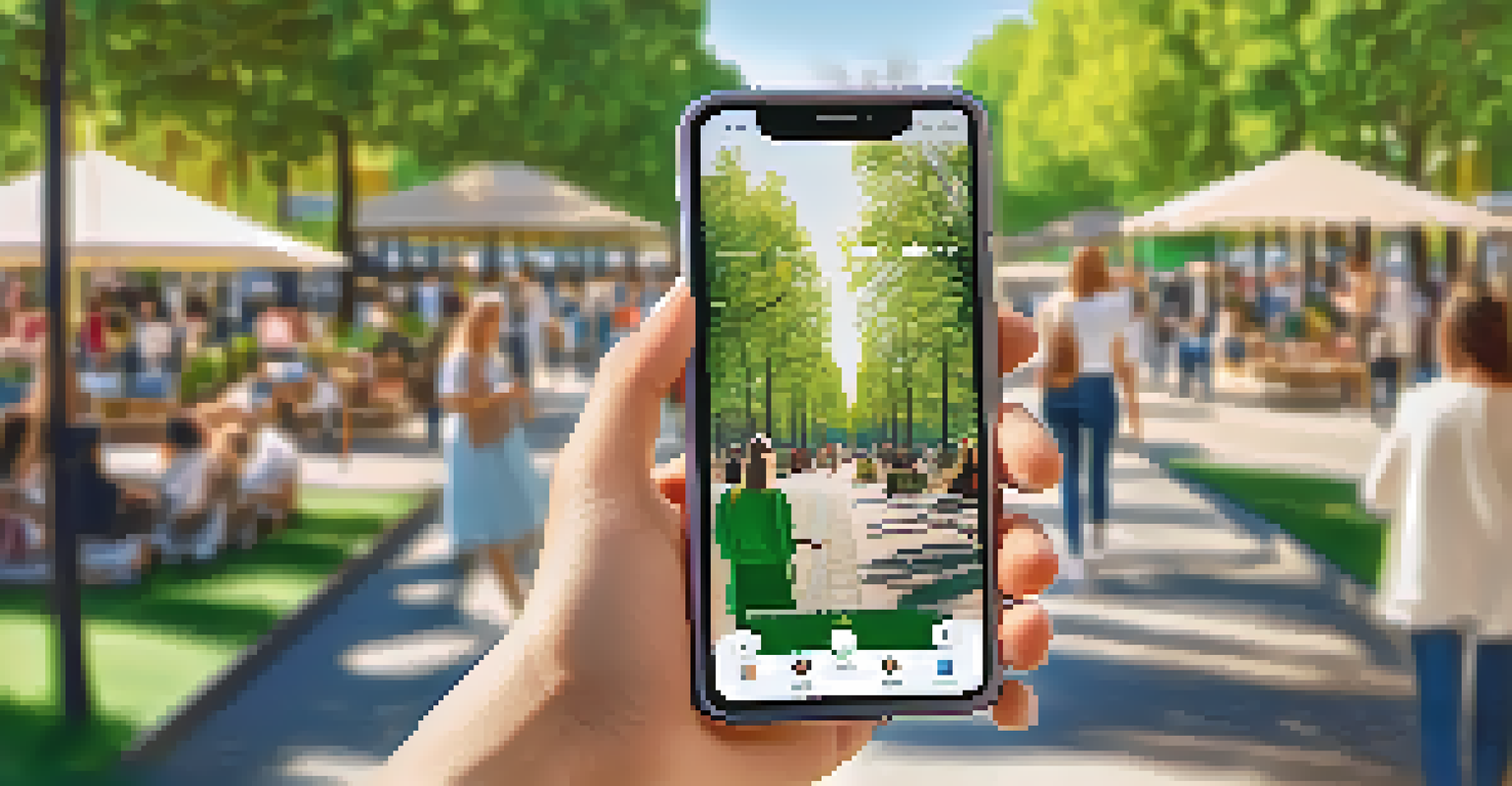The Future of Mobile Shopping: Innovations to Watch

The Rise of Augmented Reality in Mobile Shopping
Augmented reality (AR) is transforming how we shop on our mobile devices. Imagine being able to see how a piece of furniture looks in your living room before you buy it, all through your smartphone. This technology enhances the shopping experience by allowing customers to visualize products in their own environments, making decisions easier and more informed.
Augmented reality is not just a trend; it’s becoming a standard expectation in mobile shopping.
Retailers are increasingly adopting AR features in their apps, allowing users to try on clothes virtually or see how makeup looks on their skin tone. For example, companies like Sephora and IKEA have successfully implemented AR tools that have led to higher customer satisfaction and increased sales. This seamless integration of AR into mobile shopping is not just a trend; it’s becoming a standard expectation.
As AR technology continues to advance, we can expect even more immersive experiences that blur the lines between online and in-store shopping. With the potential for personalized experiences, AR is set to play a significant role in enhancing customer engagement and driving conversions.
Personalization: The Key to Enhanced User Experience
In an age where consumers are bombarded with choices, personalization has emerged as a game-changer in mobile shopping. By leveraging data analytics, retailers can tailor their offerings based on individual preferences and shopping behaviors. This not only boosts customer satisfaction but also encourages brand loyalty, as shoppers feel understood and valued.

For instance, think about how Netflix suggests shows based on your viewing history. Similarly, mobile shopping apps can recommend products based on previous purchases or browsing habits. This level of customization makes the shopping experience more relevant, increasing the likelihood of conversion and repeat business.
AR Enhances Mobile Shopping Experience
Augmented reality allows customers to visualize products in their own spaces, making shopping more informed and enjoyable.
As artificial intelligence continues to evolve, we can anticipate even more sophisticated personalization strategies. From AI-driven chatbots that offer product recommendations to dynamic pricing models, the future of mobile shopping will be all about meeting the unique needs of each customer.
Voice Commerce: Shopping at the Speed of Sound
Voice commerce is gaining traction as smart speakers and voice assistants become household staples. This innovation allows consumers to shop hands-free, simply by speaking their requests. Whether it’s adding items to a cart or making a purchase, voice commands streamline the entire shopping process, making it more convenient than ever.
In the age of digital transformation, personalization is the key to building meaningful relationships with consumers.
Imagine cooking in the kitchen and asking your voice assistant to order groceries without lifting a finger. This level of convenience is particularly appealing to busy individuals who may not have the time to scroll through apps. As voice recognition technology improves, we can expect voice commerce to become an integral part of the mobile shopping landscape.
Moreover, brands are beginning to optimize their content for voice search, ensuring that their products are easily discoverable through these platforms. As consumers increasingly embrace voice technology, retailers will need to adapt to this shift to stay competitive in the mobile shopping arena.
Mobile Wallets: The Future of Seamless Payments
Mobile wallets are revolutionizing the way we pay for goods and services. By storing credit cards and other payment information securely on our smartphones, consumers can make purchases quickly and easily. This convenience not only enhances the shopping experience but also encourages impulse buying, as transactions can be completed in just a few taps.
With the rise of contactless payments, mobile wallets are becoming the preferred method of payment for many shoppers. Retailers are capitalizing on this trend by integrating mobile payment options into their apps, making it easier for customers to check out. As security measures evolve, consumers will feel more confident using mobile wallets for larger purchases as well.
Personalization Boosts Customer Loyalty
Tailoring offerings based on individual preferences through data analytics increases customer satisfaction and encourages repeat business.
Looking ahead, we can expect to see advancements in mobile wallet technology, such as enhanced security features and the integration of cryptocurrencies. This shift will likely reshape the future of payments and create new opportunities for both consumers and retailers.
Social Commerce: Shopping Through Social Media Platforms
Social media platforms are no longer just for connecting with friends; they have become powerful shopping tools. Social commerce enables users to discover and purchase products directly through platforms like Instagram and Facebook. This trend is driven by the rise of influencer marketing, where brands collaborate with social media personalities to showcase their products.
For many consumers, shopping on social media feels more organic and engaging. By integrating shopping features into their platforms, social media companies facilitate a more seamless transition from discovery to purchase. This trend not only benefits consumers but also provides brands with direct access to their target audiences.
As social commerce continues to evolve, we can expect more innovative shopping features that enhance the experience. From shoppable posts to live-stream shopping events, social media is set to play a pivotal role in the future of mobile shopping.
Sustainability in Mobile Shopping: Eco-Friendly Innovations
Sustainability is becoming a crucial factor in consumer purchasing decisions, and mobile shopping is no exception. As awareness of environmental issues grows, shoppers are increasingly seeking out eco-friendly products and brands. Retailers are responding by integrating sustainability into their mobile shopping experiences, making it easier for consumers to make conscious choices.
For example, some apps now highlight sustainable brands or offer filters that allow users to search for eco-friendly products. This transparency not only helps consumers make informed decisions but also encourages brands to adopt more sustainable practices. As technology advances, we can expect to see even more innovative solutions that promote sustainability.
Voice Commerce Simplifies Shopping
Voice assistants streamline the shopping process by allowing consumers to make purchases hands-free, enhancing convenience.
In the coming years, mobile shopping will likely see a surge in demand for eco-friendly packaging options and carbon-neutral delivery methods. Brands that prioritize sustainability will not only appeal to environmentally-conscious consumers but also position themselves as leaders in the mobile shopping space.
The Integration of Artificial Intelligence in Shopping Apps
Artificial intelligence (AI) is set to revolutionize mobile shopping by enhancing user experiences and streamlining operations. From AI-powered chatbots that assist with customer inquiries to personalized product recommendations, AI technologies are making shopping more efficient and enjoyable. This innovation allows retailers to engage with customers in real-time, improving overall satisfaction.
Consider how Netflix uses AI to analyze viewing habits and suggest new shows. Similarly, mobile shopping apps can harness this technology to analyze consumer behavior and tailor suggestions that resonate with individual preferences. This level of personalization not only drives sales but also fosters a deeper connection between brands and consumers.

As AI continues to evolve, we can expect more advanced features, such as predictive analytics that anticipate customer needs and preferences. By embracing AI, retailers can stay ahead of the competition and create a more dynamic mobile shopping experience.